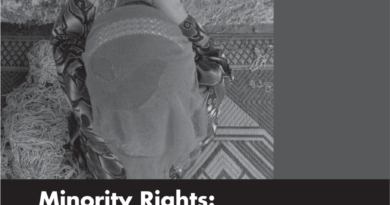Minorities and Indigenous Peoples in the United States of America

Minorities and Indigenous Peoples in the United States of America
In 1776, the United States of America signed the Declaration of Independence, which said that all people are created equal and that human rights, including “life, liberty, and the pursuit of happiness,” are “inalienable.” The Bill of Rights, or the first ten amendments to the United States Constitution, ensure equal access to a wide range of civil rights and privileges. The thirteenth amendment prohibits slavery, and the fourteenth guarantees equal protection under the law.
These provisions, however, were purposefully misinterpreted until the mid-twentieth century, allowing for the disenfranchisement of women and minority groups, the dispossession of indigenous peoples, official segregation, discrimination in education, employment, and housing, and unequal access to public services. The United States Supreme Court is the highest court in the country.
Governance
The United States’ principles of civil rights, integration, universal equality, and independence have inspired human rights around the world. The United States is largely, but not totally, an immigrant nation. Since the sixteenth century, when North America was conquered, the ‘white’ Christian majority has maintained dominance. Since the United States gained independence in 1776, government policy has progressed from slavery and conquest through segregation and exploitation to an official position favoring minority integration and even self-determination.
In the United States, new voter registration methods have been pushed as a strategy to increase minority election participation. The 1965 Voting Rights Act required that voting districts be redrawn to benefit minorities. The Act was passed in 1965 to put an end to segregation in the workplace.
Following the events of September 11, 2001, the United States passed domestic legislation to address homeland security in the face of a perceived terrorist threat; however, such legislation has had a negative impact on minorities, particularly Muslims and/or people of Middle Eastern or South Asian ancestry. Men and women have visited mosques less frequently or quit altogether, and entire families have fled North America for their home countries, sometimes in dangerous situations.
Along with other recent legislation like the Patriot Act I and II, the current material witness statute in the United States has had a negative influence on the civil rights of persons of minority communities. The Material Witness Act is a federal law that protects anyone who has information that could be used against them. Since the 1960s, minorities in the United States have shared a common pattern of experience. Cultural awareness, community organizing, and political participation were all brought about by civil rights campaigns. Although a small fraction of each group entered the middle class, often abandoning traditional ethnic neighborhoods for the suburbs, the less well-educated and financially secure saw their communities and personal fortunes deteriorate. Holding on to middle-class gains has also proven challenging in many circumstances. The Pew Charitable Trusts has released research.
Minorities
- African Americans
- Arab and other Middle Eastern Americans
- Asian-Pacific Americans
- Haitians
- Inuit and Alaska Natives
- Latinos
- Native Americans
- Native Hawai’ians
Resources
American Civil Liberties Union (ACLU) Worlds Apart: How Deporting Immigrants after 9/11 Tore Families Apart and Shattered Communities, New York, ACLU, December 2004.
American Civil Liberties Union (ACLU) America’s Disappeared: Seeking International Justice for Immigrants Detained after September 11, New York, ACLU, January 2004.
Claiborne, L. et al., Race, and Law in Britain and the United States, London, MRG, 1983.
Human Rights Watch and American Civil Liberties Union, Human Rights Violations in the United States: A Report on US Compliance with the International Covenant on Civil and Political Rights, HRW/ACLU, New York, 1993.
Zack, N. (ed.), American Mixed Race: The Culture of Micro diversity, Lanham, MD, Rowman and Littlefield, 1995.
African Americans
Black Aids Institute, AIDS in Black Face: 25 Years of an Epidemic, New York, 2006, URL: www.blackaids.org
Haas, M., Institutional Racism: The Case of Hawai’i, Westport, CT, Praeger, 1992.
Leadership Conference on Civil Rights (LCCR) and Leadership Conference on Civil Rights Education Fund (LCCREF), Justice On Trial: Racial Disparities in the American Criminal Justice System, Washington, DC, 2000, URL: http://www.civilrights.org/publications/reports/cj/
National Urban League, The State of Black America 2006, New York, National Urban League, 2006.
Pinkney, A., Black Americans, 4th in, Englewood Cliffs, NJ, Prentice-Hall, 1993.
Stepick, A., Haitian Refugees in the USA, London, MRG, 1986.

